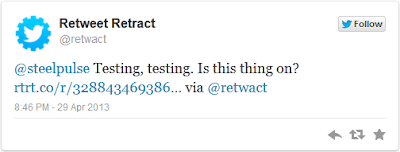The tool is called Retweet Retract — or Retwact, for short. Built as a side project by Stonly Baptiste, a software developer at the Pennsylvania-based company independenceIT, Retwact tries to contain the damage (and shame) that comes along with spreading information that later turns out to be untrue.
Here's how it works. Once you've given it permission to look at your account, the app culls your five most recent tweets that have garnered retweets.
Click on one of them, and a little green radio button fills in. Down below, you can tap out a hand-written apology or send the correction as-is. When you publish the notice, it goes from your account to all your followers. Meanwhile, Retwact's own Twitter account (@Retwact) reaches out with an @-mention to the first 100 people who retweeted your (incorrect) tweet.
Baptiste told me he hacked the tool together in a "sleepless" 48-hour session, using resources he'd never worked with before such as OAuth and the Twitter API. That was after he'd posted the idea to the social news aggregator Hacker News, where it got promoted to the front page within an hour and received upwards of 1,500 requests for Retwact to be built. (Twitter, are you listening?)
Retwact isn't perfect. If you tweet often, you can only use the service to correct something you tweeted minutes rather than hours ago. And Retwact can't detect manual retweets of misinformation — just the ones produced when you click Twitter's own retweet button.
Baptiste said he plans to keep working. He's considering adding a feature that will delete the original, misinformed tweet altogether while still preserving the text on the correction page. That means there'll still be a record of the mistake, but other users will no longer be able to spread it around.
Baptiste promises to improve the app until "A) People stop using it, or B) Twitter (or someone else) offers me a lot of money for it."
Mashable composite, images courtesy of Flickr, NASA and Twitter

No comments:
Post a Comment